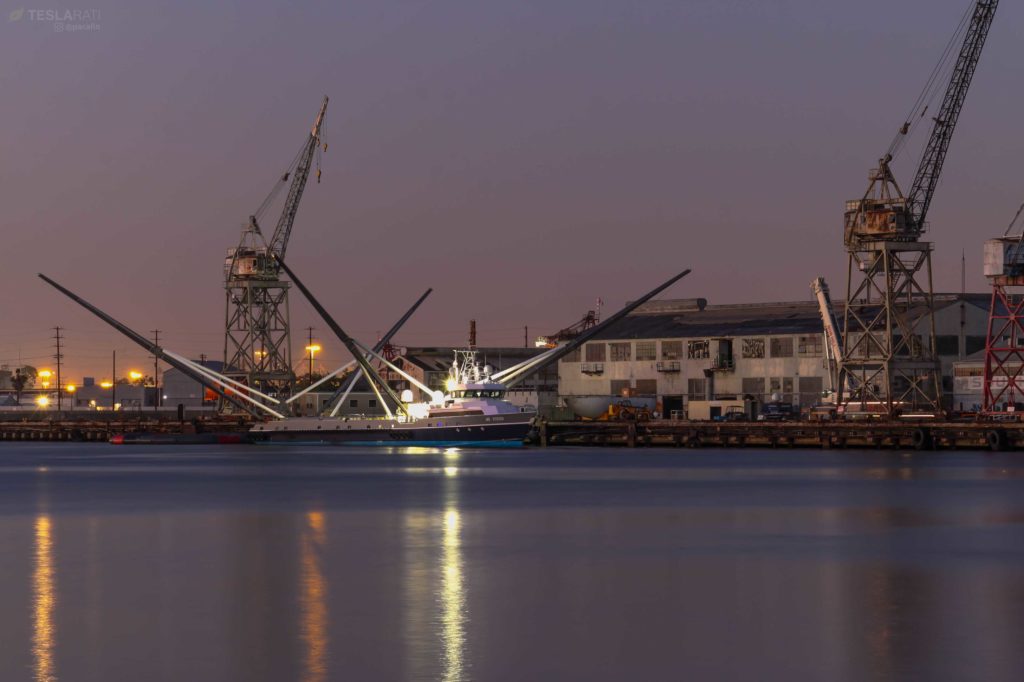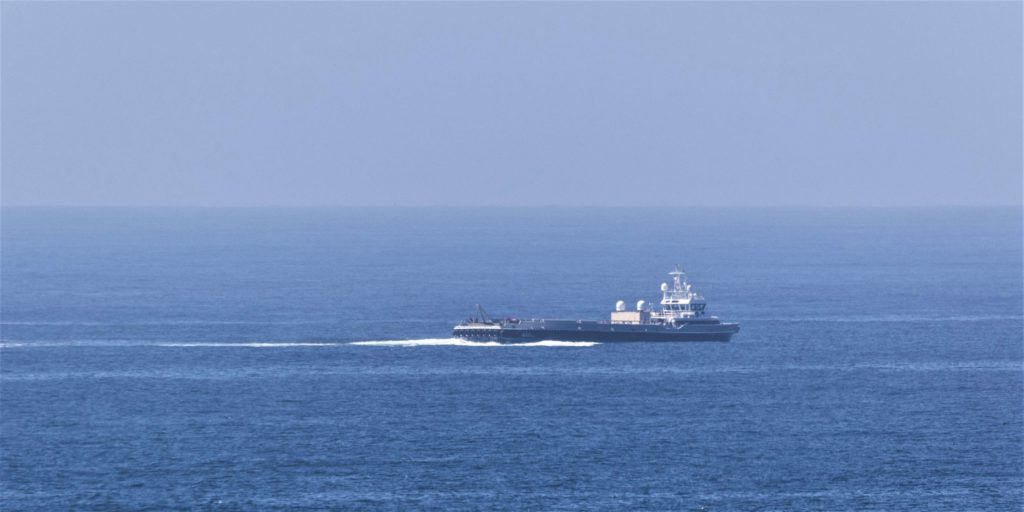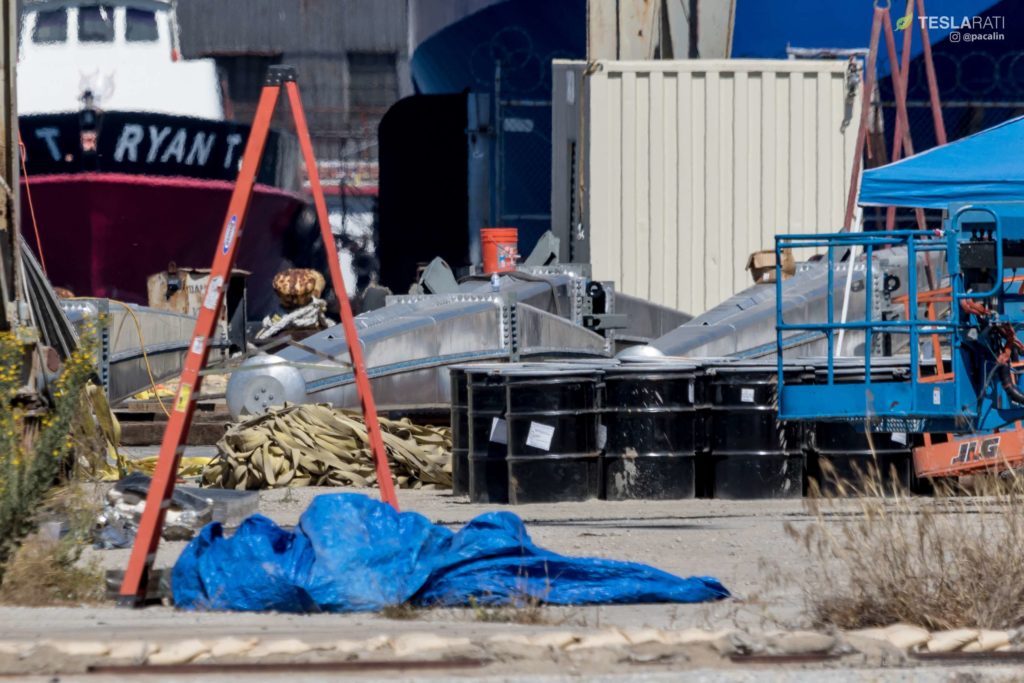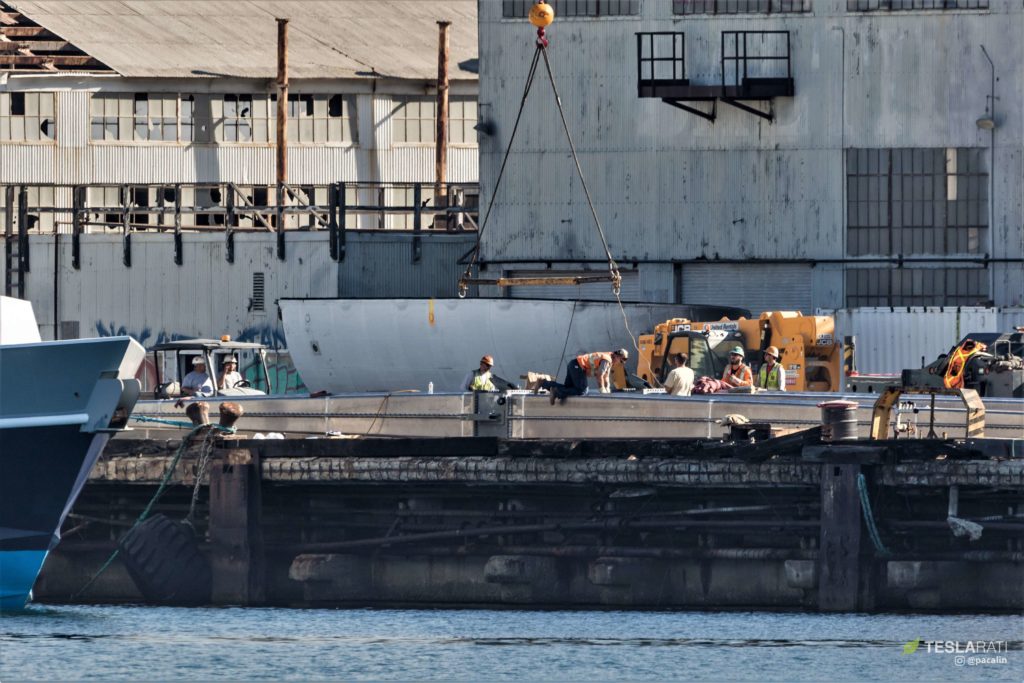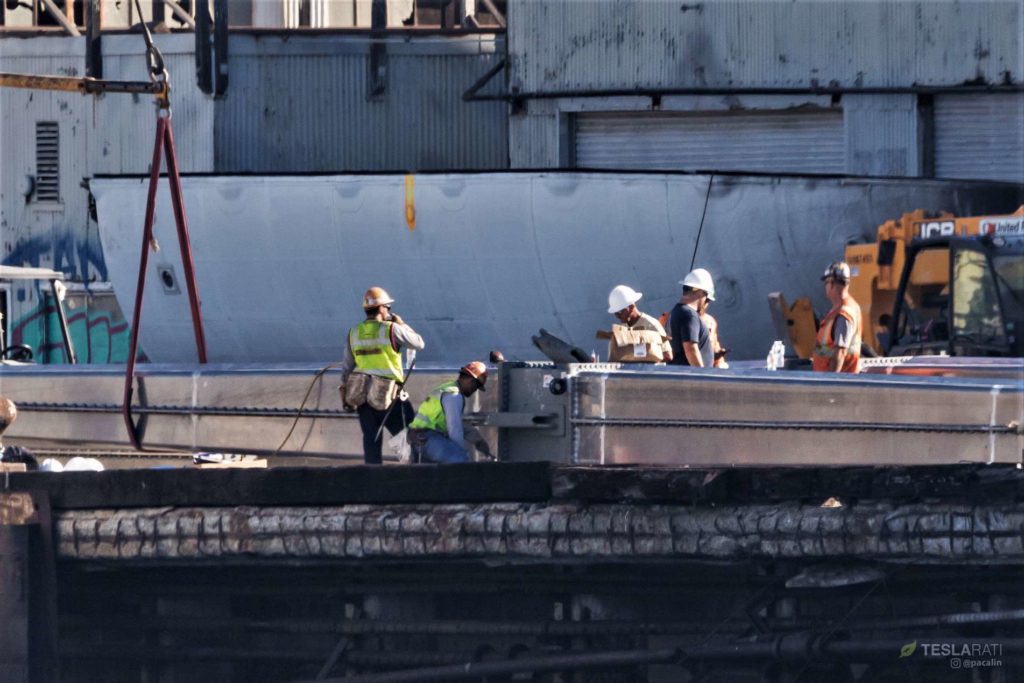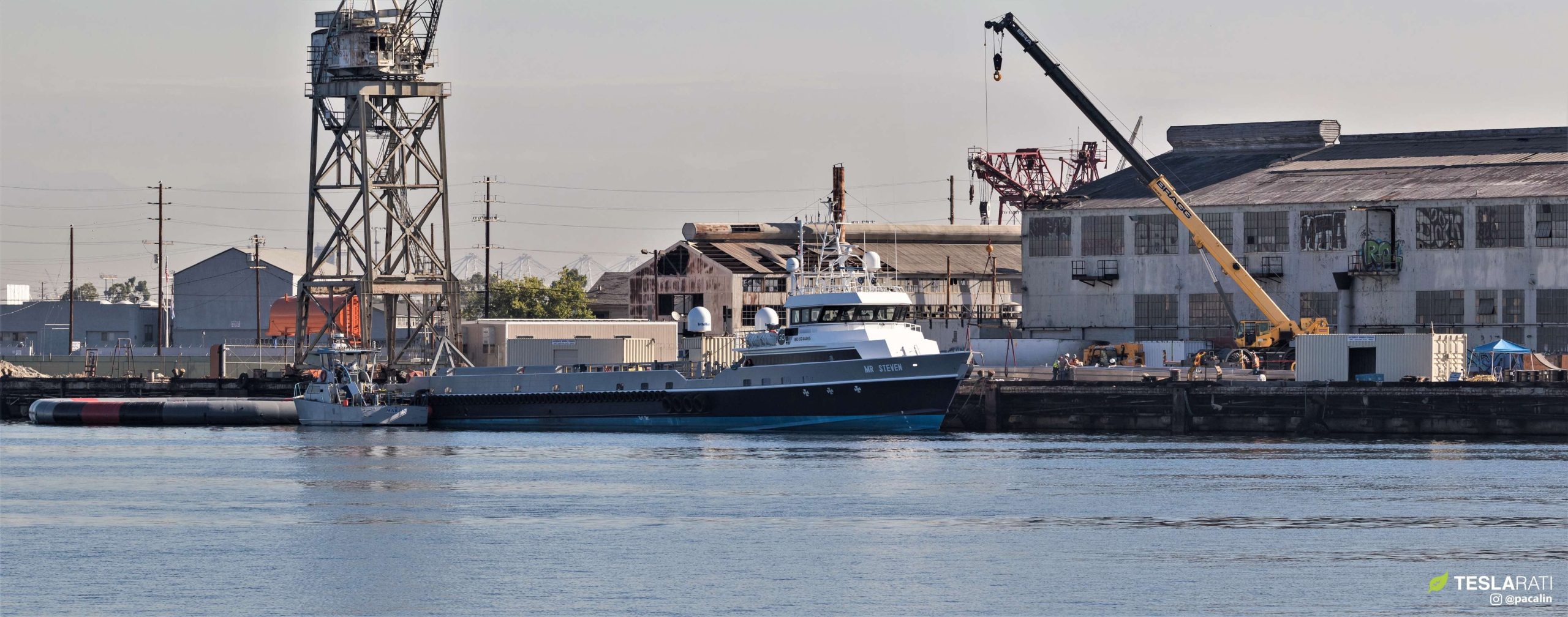
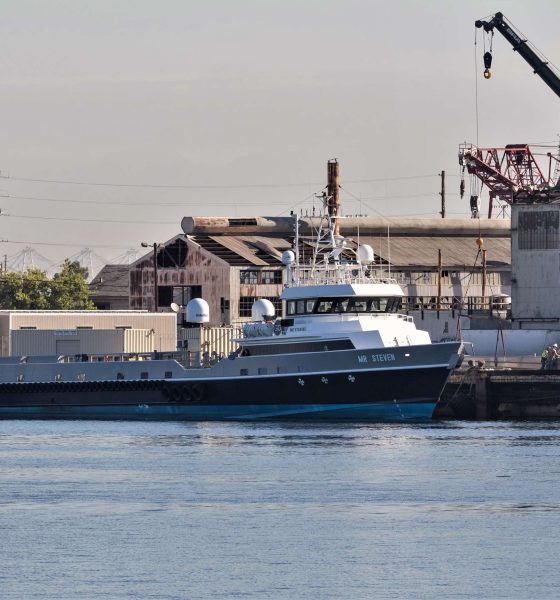
SpaceX
SpaceX’s Falcon 9 fairing catcher Mr Steven preps for October recovery attempt
Following a 45-day armless hiatus, SpaceX fairing recovery vessel Mr Steven’s four net-supporting arms have reappeared at its Berth 240 home, potentially giving SpaceX technicians enough time to install them for a fifth attempt at snagging a Falcon 9 fairing half.
That fifth Falcon fairing recovery attempt could occur as early as ~8 pm PDT, October 6th, roughly half an hour after SpaceX is scheduled to launch a flight-proven Falcon 9 Block 5 rocket with SAOCOM-1A, a 3000 kg (6600 lb) Earth observation satellite built for Argentinian space agency CONAE.
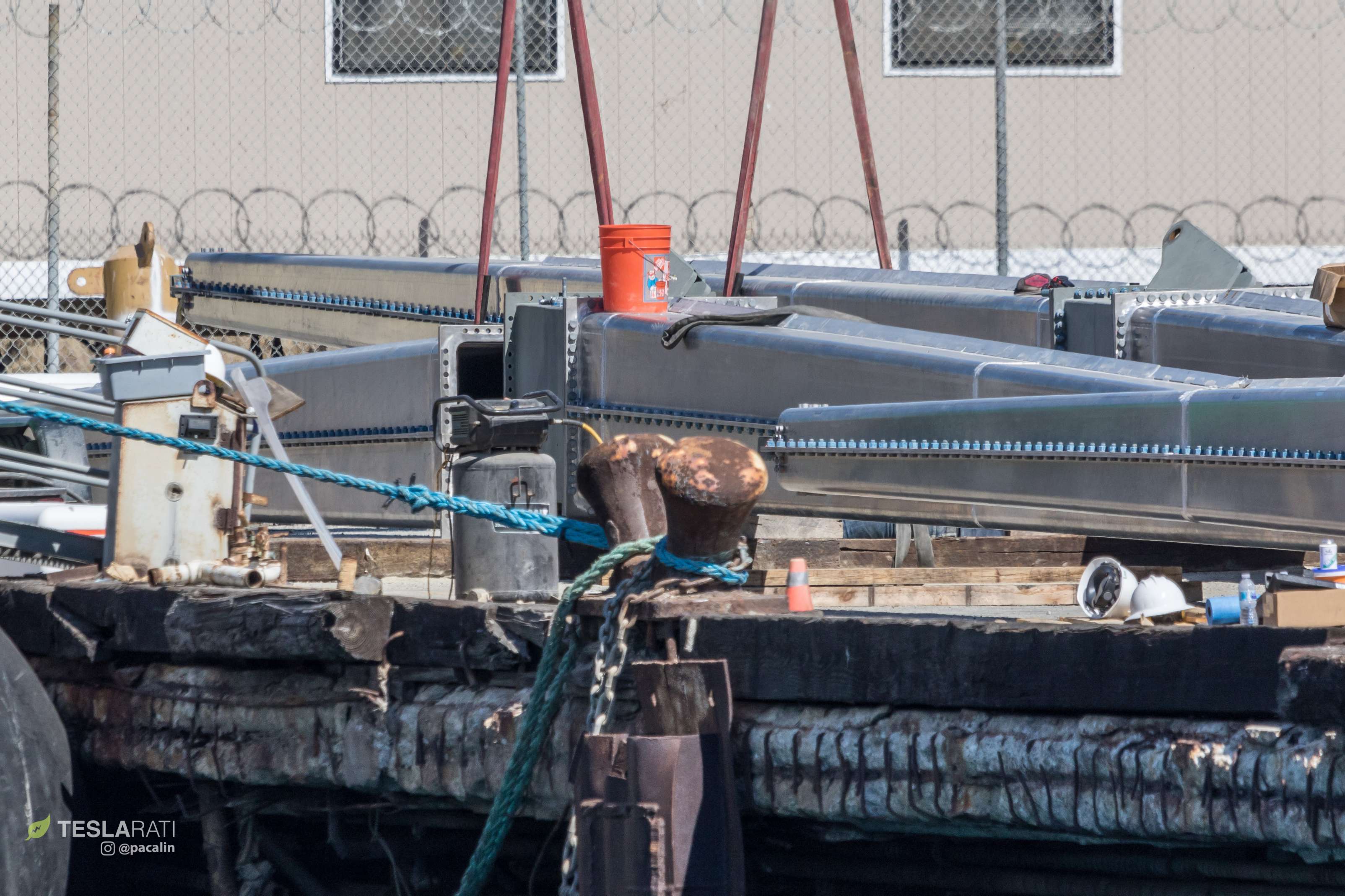
SpaceX’s most recent Vandenberg launch and fairing recovery attempt occurred on July 25th and successfully placed the sixth group of 10 Iridium NEXT communications satellites into orbit, after which Falcon 9 B1048 managed a safe landing aboard drone ship Just Read The Instructions (JRTI). JRTI returned to Port of San Pedro on July 28th and Block 5 booster B1048 has spent its subsequent ~70 days on dry land being refurbished for SAOCOM-1A, perhaps providing a taste of things to come for SpaceX launch operations.
Mr Steven, on the other hand, has been relegated to its Port of Los Angeles berth for the last month and a half, following the removal of his four arms, eight complementary booms, and large net. Presumably scheduled for upgrades after additional real-world testing, those arms and booms disappeared from Berth 240 around August 22nd and were spotted back beside Mr Steven on October 1st. Curiously, at least one arm had legible shipping manifest stickers applied, suggesting that the central arm structure, an entire arm, or even all four arms were shipped somewhere by air in interim.
- Mr Steven with arms, August 3rd. (Pauline Acalin)
- No arms, no problem. 09/18/18 (Pauline Acalin)
- Once at the dock, SpaceX technicians reassembled arm components, presumably preparing to reinstall them on Mr Steven. (Pauline Acalin)
- (Pauline Acalin)
Thanks to a new structural design allowing each arm to be easily disassembled into half a dozen major subsections, air shipment is likely a breeze compared to nearly all other large pieces of SpaceX hardware. Where or why they were shipped is unclear, although the expense of transporting ungainly and heavy items by air may indicate that schedule margins were too tight and the distance too far for road transport.
Mr Steven’s eight shock-absorbing arm booms have yet to be spotted at or around Berth 240, but chances are looking good for the vessel to have his arms reattached in time to attempt a fairing catch shortly after SAOCOM-1A. Judging from photos of the recently returned arms, any obvious before and after differences are few and far between, meaning that any visible upgrades to the recovery mechanism will instead be found with the booms.
It certainly appears that Mr Steven's net is capable of receiving a fairing half. Getting closer than ever. 8/13 #spaceX #mrsteven pic.twitter.com/Zqydum2FbB
— Pauline Acalin (@w00ki33) August 14, 2018
Longer arm booms could perhaps increase the working area of Mr Steven’s arms at the cost of dropping his net closer to the deck and late-July testing that involved placing an actual fairing on the net appeared to indicate that margin is available to lower his net further. We’ll find out soon as the booms arrive and SpaceX technicians (hopefully) begin reinstalling the vessel’s arms and net over the next several days.
For prompt updates, on-the-ground perspectives, and unique glimpses of SpaceX’s rocket recovery fleet check out our brand new LaunchPad and LandingZone newsletters!

Elon Musk
Starlink passes 9 million active customers just weeks after hitting 8 million
The milestone highlights the accelerating growth of Starlink, which has now been adding over 20,000 new users per day.

SpaceX’s Starlink satellite internet service has continued its rapid global expansion, surpassing 9 million active customers just weeks after crossing the 8 million mark.
The milestone highlights the accelerating growth of Starlink, which has now been adding over 20,000 new users per day.
9 million customers
In a post on X, SpaceX stated that Starlink now serves over 9 million active users across 155 countries, territories, and markets. The company reached 8 million customers in early November, meaning it added roughly 1 million subscribers in under seven weeks, or about 21,275 new users on average per day.
“Starlink is connecting more than 9M active customers with high-speed internet across 155 countries, territories, and many other markets,” Starlink wrote in a post on its official X account. SpaceX President Gwynne Shotwell also celebrated the milestone on X. “A huge thank you to all of our customers and congrats to the Starlink team for such an incredible product,” she wrote.
That growth rate reflects both rising demand for broadband in underserved regions and Starlink’s expanding satellite constellation, which now includes more than 9,000 low-Earth-orbit satellites designed to deliver high-speed, low-latency internet worldwide.
Starlink’s momentum
Starlink’s momentum has been building up. SpaceX reported 4.6 million Starlink customers in December 2024, followed by 7 million by August 2025, and 8 million customers in November. Independent data also suggests Starlink usage is rising sharply, with Cloudflare reporting that global web traffic from Starlink users more than doubled in 2025, as noted in an Insider report.
Starlink’s momentum is increasingly tied to SpaceX’s broader financial outlook. Elon Musk has said the satellite network is “by far” the company’s largest revenue driver, and reports suggest SpaceX may be positioning itself for an initial public offering as soon as next year, with valuations estimated as high as $1.5 trillion. Musk has also suggested in the past that Starlink could have its own IPO in the future.
News
SpaceX shades airline for seeking contract with Amazon’s Starlink rival

SpaceX employees, including its CEO Elon Musk, shaded American Airlines on social media this past weekend due to the company’s reported talks with Amazon’s Starlink rival, Leo.
Starlink has been adopted by several airlines, including United Airlines, Qatar Airways, Hawaiian Airlines, WestJet, Air France, airBaltic, and others. It has gained notoriety as an extremely solid, dependable, and reliable option for airline travel, as traditional options frequently cause users to lose connection to the internet.
Many airlines have made the switch, while others continue to mull the options available to them. American Airlines is one of them.
A report from Bloomberg indicates the airline is thinking of going with a Starlink rival owned by Amazon, called Leo. It was previously referred to as Project Kuiper.
American CEO Robert Isom said (via Bloomberg):
“While there’s Starlink, there are other low-Earth-orbit satellite opportunities that we can look at. We’re making sure that American is going to have what our customers need.”
Isom also said American has been in touch with Amazon about installing Leo on its aircraft, but he would not reveal the status of any discussions with the company.
The report caught the attention of Michael Nicolls, the Vice President of Starlink Engineering at SpaceX, who said:
“Only fly on airlines with good connectivity… and only one source of good connectivity at the moment…”
CEO Elon Musk replied to Nicolls by stating that American Airlines risks losing “a lot of customers if their connectivity solution fails.”
American Airlines will lose a lot of customers if their connectivity solution fails
— Elon Musk (@elonmusk) December 14, 2025
There are over 8,000 Starlink satellites in orbit currently, offering internet coverage in over 150 countries and territories globally. SpaceX expands its array of satellites nearly every week with launches from California and Florida, aiming to offer internet access to everyone across the globe.
Currently, the company is focusing on expanding into new markets, such as Africa and Asia.
News
Tesla hints at Starlink integration with recent patent
“By employing polymer blends, some examples enable RF transmission from all the modules to satellites and other communication devices both inside and outside the vehicle.”

Tesla hinted at a potential Starlink internet terminal integration within its vehicles in a recent patent, which describes a vehicle roof assembly with integrated radio frequency (RF) transparency.
The patent, which is Pub. No U.S. 2025/0368267 describes a new vehicle roof that is made of RF-transparent polymer materials, allowing and “facilitating clear communication with external devices and satellites.”
Tesla believes that a new vehicle roof design, comprised of different materials than the standard metallic or glass elements used in cars today, would allow the company to integrate modern vehicular technologies, “particularly those requiring radio frequency transmission and reception.
Tesla has recently filed a US patent application on integrating RF transparent materials into the roof structure.
“facilitating clear communication with external devices and satellites”
Tesla fleet is getting @Starlink connectivity integration soon. LFG @Tesla @elonmusk… pic.twitter.com/bLa8YtPLd1
— Chansoo Byeon (@Chansoo) December 9, 2025
Instead of glass or metallic materials, Tesla says vehicles may benefit from high-strength polymer blends, such as Polycarbonate, Acrylonitrile Butadiene Styrene, or Acrylonitrile Styrene Acrylate.
These materials still provide ideal strength metrics for crashworthiness, stiffness for noise, vibration, and harshness control, and are compliant with head impact regulations.
They would also enable better performance with modern technologies, like internet terminals, which need an uninterrupted signal to satellites for maximum reception. Tesla writes in the patent:
“By employing polymer blends, some examples enable RF transmission from all the modules to satellites and other communication devices both inside and outside the vehicle.”

One of the challenges Tesla seems to be aware of with this type of roof design is the fact that it will still have to enable safety and keep that at the forefront of the design. As you can see in the illustration above, Tesla plans to use four layers to increase safety and rigidity, while also combating noise and vibration.
It notes in the patent that disclosed examples still meet the safety requirements outlined in the Federal Motor Vehicle Safety Standards (FMVSS).
Starlink integrated directly into Tesla vehicles would be a considerable advantage for owners. It would come with a handful of distinct advantages.
Initially, the inclusion of Starlink would completely eliminate cellular dead zones, something that is an issue, especially in rural areas. Starlink would provide connectivity in these remote regions and would ensure uninterrupted service during road trips and off-grid adventures.
It could also be a critical addition for Robotaxi, as it is crucial to have solid and reliable connectivity for remote monitoring and fleet management.
Starlink’s growing constellation, thanks to SpaceX’s routine and frequent launch schedule, will provide secure, stable, and reliable internet connectivity for Tesla vehicles.
Although many owners have already mounted Starlink Mini dishes under their glass roofs for a similar experience, it may be integrated directly into Teslas in the coming years, either as an upgrade or a standard feature.
